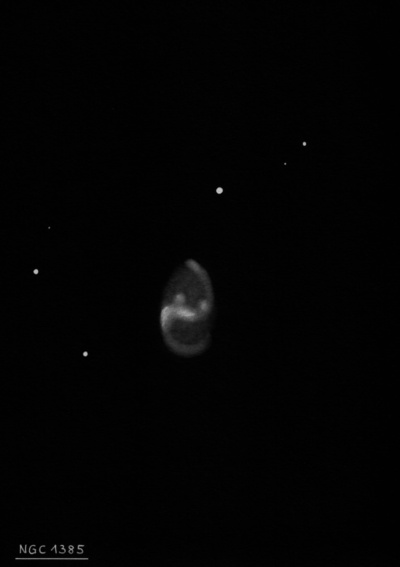
William Herschel discovered NGC 1385 = H II-263 = h2563 on 17 Nov 1784 (sweep 321) and recorded "F but less bright than the last [NGC 1371], bM, about 1.5' dia." His position is 4' too far north-northwest. John Herschel called this object "B, R, gpmbM, 40 arcsec" and measured an accurate position.
200/250mm - 8" (10/13/81): faint, fairly small, brighter core.
400/500mm - 17.5" (11/26/94): fairly bright, moderately large. Dimensions are 2.5'x2.0' slightly elongated N-S, but with an irregular appearance. A bright bar appears to extend through the galaxy WNW-ESE surrounded by an irregular patchy halo more elongated N-S. Spiral structure is strongly suggested with a spiral arm on the NE side. The galaxy appears more extensive north of the bar. Located within a 10' string of four mag 11-12 stars oriented SW-NE.
900/1200mm - 48" (10/29/19): at 610x; very bright, large, excellent spiral with an unusual, chaotic appearance! Overall, the galaxy is elongated ~5:3 N-S, ~3.0'x1.8', with a prominent thick bar running ~E-W through the center. A small, bright knot is close north of the west end of the bar.
A brighter, elongated patch (probably a short section of a spiral arm) was easily seen extending north of the bar. Only the initial part of the southern arm attached to the west end of the bar was visible. The main, long spiral arm was rooted on the east end of the bar and stretched well north of the central region. Its surface brightness seemed irregular or patchy. The arm faded and was less defined as it curled clockwise and spread west on the north end of the halo. The south portion of the halo was faint overall (due to dust) but displayed a semi-circular outline due to the very low surface brightness southern arm.
LEDA 788671 was picked up 3.5' S of NGC 1385. This small galaxy was faint (B = 16.4) and ~12" in diameter.
Notes by Steve Gottlieb